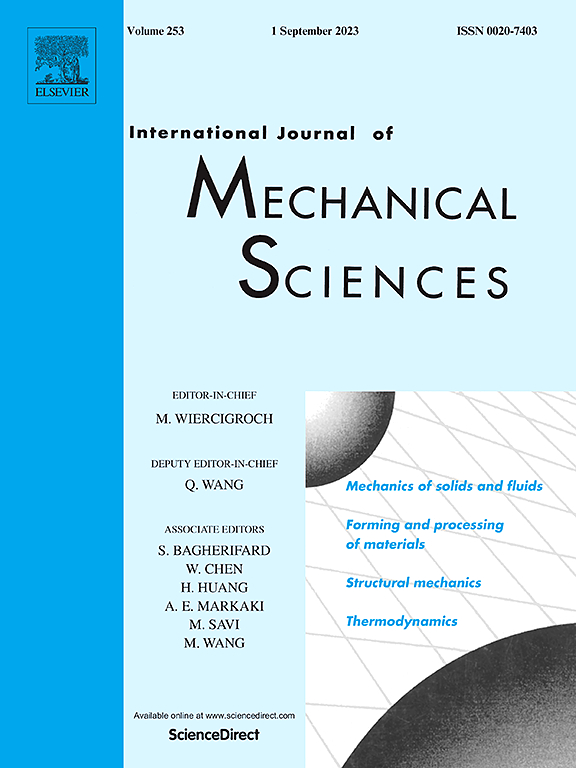离子共价硫化银塑性机理的原子视角研究
IF 9.4
1区 工程技术
Q1 ENGINEERING, MECHANICAL
International Journal of Mechanical Sciences
Pub Date : 2025-06-07
DOI:10.1016/j.ijmecsci.2025.110471
引用次数: 0
摘要
由于原子键合的多样性,良好的塑性和可加工性通常被认为是金属的标志特征。α-Ag2S等新型塑性无机半导体挑战了这一传统思维,但相关第一性原理计算仍然缺乏对潜在塑性机制的直观和全面理解。本工作从能够恰当描述微观结构演化的机器学习分子动力学角度,揭示了离子共价体系α-Ag2S的可塑性机制。结果表明,可动Ag稳定的S亚晶格在变形过程中起骨架作用,而α-Ag2S的力学响应是亚晶格相关的。由随机和局部微扭产生的剪切带或扭结带表示塑性特征,随后的非晶化使高应变下的持续变形成为可能。与金属不同的是,α-Ag2S中相反符号的位错对通过协调的晶格扩张和收缩实现成核和运动,而交错触发的缠绕状扭结使材料能够适应较大的剪切应变。建立的理想模型捕获了非常规位错对和伪孪生扭结,缩小了我们对类似系统中塑性机制理解的盲区。总结出的新的结构和变形特征为在超离子导体中识别其他塑性离子共价晶体提供了清晰的线索。本文章由计算机程序翻译,如有差异,请以英文原文为准。

Atomic perspective on plasticity mechanism of ionic-covalent silver sulfide
Due to the diversity of atomic bonding, good plasticity and machinability are often considered hallmark characteristics of metals. Novel plastic inorganic semiconductors like α-Ag2S have challenged this conventional thinking, but relevant first-principles calculations still lack an intuitive and comprehensive understanding of the underlying plasticity mechanisms. From the perspective of machine learning molecular dynamics that can describe the microstructure evolution aptly, this work reveals the plasticity mechanism of the ionic-covalent system α-Ag2S. It is found that the S sublattice stabilized by movable Ag acts as a framework during deformation, while the mechanical response of α-Ag2S is sublattice-dependent. Shear bands or kink bands originating from random and local micro-kinks signify the plastic features, and the subsequent amorphization enables sustained deformation under high strains. Different from features in metals, the oppositely signed dislocation pairs in α-Ag2S can achieve nucleation and motion through coordinated lattice expansion and contraction, while the twining-like kink triggered in a staggered manner allows the material to accommodate large shear strains. The established idealized models capture the unconventional dislocation pair and pseudo-twinning kink, narrowing the blind area in our understanding of plasticity mechanisms within similar systems. The summarized novel structural and deformation features provide clear clues for identifying other plastic ionic-covalent crystals in superionic conductors.
求助全文
通过发布文献求助,成功后即可免费获取论文全文。
去求助
来源期刊

International Journal of Mechanical Sciences
工程技术-工程:机械
CiteScore
12.80
自引率
17.80%
发文量
769
审稿时长
19 days
期刊介绍:
The International Journal of Mechanical Sciences (IJMS) serves as a global platform for the publication and dissemination of original research that contributes to a deeper scientific understanding of the fundamental disciplines within mechanical, civil, and material engineering.
The primary focus of IJMS is to showcase innovative and ground-breaking work that utilizes analytical and computational modeling techniques, such as Finite Element Method (FEM), Boundary Element Method (BEM), and mesh-free methods, among others. These modeling methods are applied to diverse fields including rigid-body mechanics (e.g., dynamics, vibration, stability), structural mechanics, metal forming, advanced materials (e.g., metals, composites, cellular, smart) behavior and applications, impact mechanics, strain localization, and other nonlinear effects (e.g., large deflections, plasticity, fracture).
Additionally, IJMS covers the realms of fluid mechanics (both external and internal flows), tribology, thermodynamics, and materials processing. These subjects collectively form the core of the journal's content.
In summary, IJMS provides a prestigious platform for researchers to present their original contributions, shedding light on analytical and computational modeling methods in various areas of mechanical engineering, as well as exploring the behavior and application of advanced materials, fluid mechanics, thermodynamics, and materials processing.
 求助内容:
求助内容: 应助结果提醒方式:
应助结果提醒方式:


